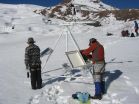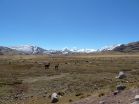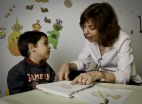Up to 30 percent less precipitation in the Central Andes in future
2015-08-17
(Press-News.org) Seasonal water shortages already occur in the Central Andes of Peru and Bolivia. By the end of the century, precipitation could fall by up to 30% according to an international team of researchers led by the University of Zurich. In a first for this region, the team compared current climate data with future climate scenarios and data extending back to pre-Inca times.
The population in the Central Andes already faces water shortages today. Now geographers at the University of Zurich have collaborated with Swiss and South American researchers to show that precipitation in the rainy season could drop noticeably - and this could happen within the next twenty years.
In contrast to conventional research projects, which often look at climate forecasts in isolation, the UZH scientists compared data taken from tree rings and ice cores from the past 1,000 years with model calculations for the future. Their research found that current precipitation is within the normal fluctuation range for recent centuries. But this is projected to change dramatically by the end of the century: «Our model simulations suggest that the probability of dry years between 2071 and 2100 will be four times higher than in the pre-industrial era», says lead author Raphael Neukom.
Stronger westerly winds lead to more aridity
It is difficult to realistically simulate precipitation in mountainous regions using current global climate models, which forced researchers to use alternative methods. They capitalised on the fact that precipitation in the tropical Andes is strongly influenced by wind speeds in the higher air layers. «These winds can be simulated much more reliably than the precipitation itself», says Raphael Neukom. «It is highly probable that the increase in greenhouse gases will strengthen the westerly winds over the Central Andes. But stronger westerly winds in the upper troposphere reduce the inflow of humid air from the Amazon region into the Andes and thus lead to greater aridity.»
Clear long-term trend
Although almost all model simulations point to a decline in precipitation, the scientists note that the model and climate scenarios still present some uncertainties. Nevertheless, «although short-term predictions can be impacted by fluctuations that go against the overall trend, our data clearly shows that over the long term, i.e. through to the end of the century, the trend towards greater aridity in the Andes is unambiguous», explains UZH glaciologist Christian Huggel. Moreover, other factors such as the deforestation of the Amazon rainforest and lower levels of glacial meltwater could exacerbate the trend.
According to Christian Huggel, there is therefore an urgent need to introduce affordable and low-risk measures that will adapt the region to the new climate conditions. Peruvian-Swiss projects are testing such measures, which include, for example, the collection of rainwater in artificial ponds. «The results of the basic research are coming at just the right time for deliberations on the dimensions of such ponds», concludes Christian Huggel.
INFORMATION:
Literature
Raphael Neukom, Mario Rohrer, Pierluigi Calanca, Nadine Salzmann, Christian Huggel, Delia Acuña, Duncan A Christie and Mariano S Morales. Facing unprecedented drying of the Central Andes? Precipitation variability over the period AD 1000-2100. Environmental Research Letters. doi: 10.1088/1748-9326/10/8/084017
South America-Swiss cooperation
The study was partially financed by the Swiss Agency for Development and Cooperation (DEZA) as part of the project «Anpassung an den Klimawandel in Peru» [Adapting to Climate Change in Peru]. In addition to concrete adaptation and development measures, this project also examines the scientific bases of climate change in the Peruvian Andes. The extraordinary collaboration between Swiss researchers from the universities of Zurich, Fribourg and Bern, the federal institute Agroscope, Meteodat GmbH and South American researchers from Peru, Argentina and Chile brings together paleoclimatologists with experts in the field of instrumental climate measurement. The aim is to quantify past, present and future climate conditions with the greatest possible precision. It is important to study medium- and long-term climate changes as precisely as possible in order to enable adaptation measures to be planned effectively. To that end, DEZA, Peruvian governmental institutions, the scientific community and NGOs are working together closely in this project.
ELSE PRESS RELEASES FROM THIS DATE:
2015-08-17
Over a 10 year period, the time that babies receive genetic testing after being diagnosed with diabetes has fallen from over four years to under two months. Pinpointing the exact genetic causes of sometimes rare forms of diabetes is revolutionising healthcare for these patients.
Babies with diabetes are now being immediately genetically tested for all possible 22 genetic causes while previously they would only get genetic testing years after diabetes was diagnosed and then the genes would be tested one at a time. Crucially, this means that the genetic diagnosis is made ...
2015-08-17
Scientists on the Dark Energy Survey, using one of the world's most powerful digital cameras, have discovered eight more faint celestial objects hovering near our Milky Way galaxy. Signs indicate that they, like the objects found by the same team earlier this year, are likely dwarf satellite galaxies, the smallest and closest known form of galaxies.
Satellite galaxies are small celestial objects that orbit larger galaxies, such as our own Milky Way. Dwarf galaxies can be found with fewer than 1,000 stars, in contrast to the Milky Way, an average-size galaxy containing ...
2015-08-17
We may view our memory as being essential to who we are, but new findings suggest that others consider our moral traits to be the core component of our identity. Data collected from family members of patients suffering from neurodegenerative disease showed that it was changes in moral behavior, not memory loss, that caused loved ones to say that the patient wasn't "the same person" anymore.
The findings are published in Psychological Science, a journal of the Association for Psychological Science.
"Contrary to what you might think -- and what generations of philosophers ...
2015-08-17
WASHINGTON, August 17, 2015 -- Almost all of us have used some type of odor eliminator like Febreze to un-stink a room. These sprays can work wonders, but how do they actually work? Do they really remove the smell or just mask it? We explain the chemistry of odor elimination in this week's Reactions video. Check it out here: https://youtu.be/sNIIxzR-d_Q.
Subscribe to the series at http://bit.ly/ACSReactions, and follow us on Twitter @ACSreactions to be the first to see our latest videos.
INFORMATION:
The American Chemical Society is a nonprofit organization chartered ...
2015-08-17
This news release is available in German.
Their results have now been published in the Nature journal Scientific Reports (doi:10.1038/srep13008) and could point the way toward improvements in hybrid solar cells.
The system they investigated is based on conventional n-type silicon wafers coated with the highly conductive polymer mixture PEDOT:PSS and displays a power conversion efficiency of about 14 %. This combination of materials is currently extensively investigated by many teams in the research community.
"We systematically surveyed the characteristic curves, ...
2015-08-17
Millions of tons of road salt are applied to streets and highways across the United States each winter to melt ice and snow and make travel safer, but the effects of salt on wildlife are poorly understood.
A new study by biologists from Case Western Reserve University suggests exposure to road salt, as it runs off into ponds and wetlands where it can concentrate--especially during March and early April, when frogs are breeding--may increase the size of wood frogs, but also shorten their lives.
Wood frog tadpoles exposed to road salt grew larger and turned into ...
2015-08-17
In addition to melting icecaps and imperiled wildlife, a significant concern among scientists is that higher Arctic temperatures brought about by climate change could result in the release of massive amounts of carbon locked in the region's frozen soil in the form of carbon dioxide and methane. Arctic permafrost is estimated to contain about a trillion tons of carbon, which would potentially accelerate global warming. Carbon emissions in the form of methane have been of particular concern because on a 100-year scale methane is about 25-times more potent than carbon dioxide ...
2015-08-17
Magnetism in nanoscale layers only a few tens of atoms thick is one of the foundations of the big data revolution - for example, all the information we download from the internet is stored magnetically on hard disks in server farms dotted across the World. Recent work by a team of scientists working in Singapore, The Netherlands, USA and Ireland, published on 14 August 2015 in the prestigious journal, Science, has uncovered a new twist to the story of thin-film magnetism.
The team from the National University of Singapore (NUS) - Mr Li Changjian, a graduate student from ...
2015-08-17
Bilingual children pose unique challenges for clinicians, and, until recently, there was little research on young bilinguals to guide clinical practice. In the past decade, however, research on bilingual development has burgeoned, and the scientific literature now supports several conclusions that should help clinicians as they assess bilingual children and advise their parents.
In an article recently published in Seminars in Speech and Language, Erika Hoff, Ph.D., a professor of psychology in the Charles E. Schmidt College of Science at Florida Atlantic University, ...
2015-08-17
ANN ARBOR, Mich. - One of the most common complaints about hospitals is the noise. Patients complain that they can't sleep soundly in the environment of multiple monitors, paging systems, wheelchairs and gurneys, and carts that squeak.
Ongoing efforts at the University of Michigan Health System are making the hospital quieter, and the hospital has tested sound panels designed to dial down noise.
During a pilot study, strategically placed sound acoustic panels helped diffuse sound in the hallways around patient rooms. The modest 3-4 sound decibel drop is recognizable ...
LAST 30 PRESS RELEASES:
[Press-News.org] Up to 30 percent less precipitation in the Central Andes in future






